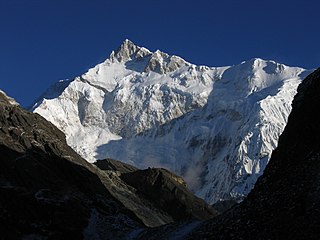
Kangchenjunga, also spelled Kanchenjunga, Kanchanjanghā and Khangchendzonga, is the third-highest mountain in the world. Its summit lies at 8,586 m (28,169 ft) in a section of the Himalayas, the Kangchenjunga Himal, which is bounded in the west by the Tamur River, in the north by the Lhonak River and Jongsang La, and in the east by the Teesta River. It lies in the border region between Nepal and Mangan district, Sikkim state of India, with three of the five peaks, namely Main, Central and South, directly on the border, and the peaks West and Kangbachen in Nepal's Taplejung District.

Kanchenjungha (Kanchonjônggha) is a 1962 Indian film directed by Satyajit Ray.

Nanda Devi is the second-highest mountain in India, after Kangchenjunga, and the highest located entirely within the country. Nanda Devi is the 23rd-highest peak in the world.
There are 18 Biosphere Reserves in India. to protect larger areas of natural habitat than a typical national park or animal sanctuary, and that often include one or more national parks or reserves, along with buffer zones that are open to some economic uses. Protection is granted not only to the flora and fauna of the protected region, but also to the human communities who inhabit these regions, and their ways of life. In total there are 18 biosphere reserves in India

Singalila National Park is a National park of India located on the Singalila Ridge at an elevation of more than 2300 metres above sea level, in the Darjeeling district of West Bengal. It is well known for the trekking route to Sandakphu that runs through it.

Khangchendzonga National Park, also Kanchenjunga Biosphere Reserve, is a national park and a biosphere reserve located in Sikkim, India. It was inscribed to the UNESCO World Heritage Sites list in July 2016, becoming the first "Mixed Heritage" site of India. It was included in the UNESCO Man and the Biosphere Programme. The park is named after the mountain Kangchenjunga, which is the third-highest peak in the world at 8,586 m (28,169 ft) tall. The total area of the park is 849.5 km2 (328.0 sq mi).

Zemu Glacier is the largest glacier in the Eastern Himalaya. It is about 26 kilometres (16 mi) in length and is located at the base of Kangchenjunga in the Himalayan region of Sikkim, India. The Zemu Glacier drains the east side of Kanchenjunga, the world's third highest mountain. The glacier is the source of water for numerous rivers, as it feeds them when it melts. One of them is the Teesta River, which has garnered large attention in the past few years because of a proposed 3500 MW hydropower plant. At the moment the Government of Sikkim has only been able to run a 510 MW plant on the river. Owing to the location of the river in an earthquake prone area, the hydropower plants will be a run of the river project.

Goecha La is a high mountain pass in Gyalshing district, Sikkim, India in the Himalaya range. The southeast face of Kanchenjunga, the world's third highest mountain, can be viewed from the pass, which is also a base camp for those aspiring to scale the mountain. They say that when the government authorities first saw the view from Goecha La, they were so moved by the view that they decided to feature it on the Rs.100 note.

Tezpur University is a Central University located in Tezpur in the North-Eastern state of Assam, India, established by an act of Parliament, in 1994.

Observatory Hill is a hill near Chowrasta square, or The Mall as it is popularly known, in Darjeeling, West Bengal, India. Views of snow-clad peaks, including Mount Kanchenjunga, are visible from the Observatory Hill. The Bhutia Busty monastery was originally located here. Now the hill has the temple of Mahakal. Two important arteries of the town, Nehru Road and Bhanubhakta Sarani, meet at Chowrasta. Another school of thought suggests that the presence of the megalithic core to have been a place of worship of the Rongs, representing a sacred location of the classic Long Chok type.

Sandakphu or Sandakpur is a mountain peak in the Singalila Ridge on the border between India and Nepal. It is the highest point of the ridge and of the state of West Bengal, India. The peak is located at the edge of the Singalila National Park and has a small village on the summit with a few hotels. Four of the five highest peaks in the world, Everest, Kangchenjunga, Lhotse and Makalu can be seen from its summit. It also affords a pristine view of the entire Kangchenjunga Range. Sandakphu is also known as the land of poisonous flowers.
Michael Graeme Groom is an Australian mountain climber. In 1995, Groom became the fourth person ever to reach the summits of the four highest mountains in the world without the aid of bottled oxygen. He proceeded to climb the fifth-highest, Makalu, in 1999. In 1987 he lost the front third of his feet to frostbite after descending from the summit of Kangchenjunga. Despite this, he later managed to summit Mount Everest in 1993 and again in 1996.
Blue Mountains may refer to:

Arjun Vajpai is an Indian mountaineer, who became the world's youngest mountaineer to summit six peaks over 8,000 meters in the year 2018.

Kanchenjunga Conservation Area is a protected area in the Himalayas of eastern Nepal that was established in 1997. It covers 2,035 km2 (786 sq mi) in the Taplejung District and comprises two peaks of Kanchenjunga. In the north it adjoins the Qomolangma National Nature Preserve in Tibet, and in the east the Khangchendzonga National Park in Sikkim. To the west it borders the Sankhuwasabha District. It ranges in elevation from 1,200 to 8,586 m. It is part of the Sacred Himalayan Landscape, which is being developed by WWF Nepal in partnership with the International Centre for Integrated Mountain Development.

The Great Himalaya Trail is a route across the Himalayas from east to west. The original concept was to establish a single long distance trekking trail from the east end to the west end of Nepal that includes a total of roughly 1,700 kilometres (1,100 mi) of path. There is a proposed trail of more than 4,500 kilometres (2,800 mi) stretching the length of the Greater Himalaya range from Nanga Parbat in Pakistan to Namche Barwa in Tibet thus passing through, India, Nepal, Bhutan and Tibet. Although an actual continuous route is currently only a concept, if completed it would be the longest and highest alpine hiking track in the world.

The Sacred Himalayan Landscape is a 39,021 km2 (15,066 sq mi) large trans-boundary landscape in the eastern Himalayas encompassing temperate broadleaf and conifer forests, alpine meadows and grasslands, which harbour more than 80 mammal and more than 440 bird species. It extends from Nepal's Langtang National Park through Sikkim and Darjeeling in India to western Bhutan's Torsa Strict Nature Reserve. More than 73% of this landscape is located in Nepal, including Sagarmatha National Park, Makalu Barun National Park, and Kanchenjunga Conservation Area. About 24% is located in India, encompassing Khangchendzonga, Singalila and Neora Valley National Parks as well as Fambong Lho, Maenam, Senchal, Mahananda Wildlife Sanctuaries, Shingba and Barsey Rhododendron Sanctuaries and Kyongnosla Alpine Sanctuary.

Northeast India consists of the eight states Arunachal Pradesh, Assam, Manipur, Meghalaya, Mizoram, Nagaland, Sikkim and Tripura. Tourism in this area is based around the unique Himalayan landscape and culture distinct from the rest of India.

Dzuluk or Zuluk or Jhuluk or Jaluk is a small hamlet located at a height of 9,400 feet (2,900 m) on the rugged terrain of the lower Himalayas in Rongli Subdivision of Pakyong District, which lies in the Indian state Sikkim. This place is relatively an emerging and offbeat destination in Sikkim. Today it is a tourist destination for the view of the eastern Himalayan mountain range including the Kanchenjunga.

Abar Kanchanjungha is a 2022 Indian Bengali-language family drama film directed by Raajhorshee De. The screenplay was written by Padmanabha Dasgupta and Raajhorshee De. The film features an ensemble cast including Anindya Chatterjee, Rupankar Bagchi, Rahul Banerjee, Gaurav Chakrabarty, Bidipta Chakraborty, Tanushree Chakraborty, Arpita Chatterjee, Saswata Chatterjee, Padmanabha Dasgupta, Devlina Kumar, and Kaushik Sen. The film was produced by Mitaa Pal, Akshatt K Pandey, and Shilpi A Pandey. It was released theatrically on 1 April 2022 and digitally on 26 May 2023 on ZEE5.
















